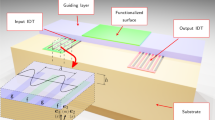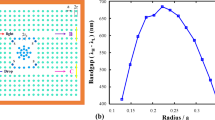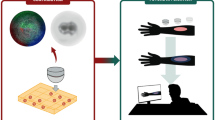Abstract
To realize the high-precision three-dimensional (3D) measurement of micro-precision devices, a 3D resonant trigger probe based on quartz tuning fork for micro/nano coordinate measuring machine (CMM) is proposed. The probe is composed of a quartz tuning fork, a tapered optical fiber stylus and a microsphere. It vibrates in resonance state and makes contact with the measured surface in the Z direction in tapping mode, while in the X and Y directions, it operates in friction mode. The 3D nano-positioning of the probe is achieved by the changes in resonance parameter caused by the interatomic force between the microsphere and the surface of the measured sample. In this study, the diameter of the probe microsphere can be as low as 80 μm, and the length of the probe stylus is approximately 5 mm. The trigger resolution of the probe in the X, Y and Z directions are 0.44, 0.41 and 0.34 nm, respectively. The probing forces in the X, Y and Z directions are 2.25, 1.81 and 4.24 μN, respectively. Experimental results verify that the proposed probe has the advantages of small size, sub-nano resolution and very low probing force. This probe can be used as the trigger probe of micro/nano CMM, which can be triggered by interatomic force.












Similar content being viewed by others
References
Alain, V., Hichem, N., Mohamed, D., et al. (2015). Implementation of capacitive probes for ultra-high precision machine for cylindricity measurement with nanometre level of accuracy. International Journal of Precision Engineering and Manufacturing., 16(5), 883–893.
Ahn, H. K., Kang, H., Ghim, Y. S., et al. (2019). Touch probe tip compensation using a novel transformation algorithm for coordinate measurements of curved surfaces. International Journal of Precision Engineering and Manufacturing., 20(2), 193–199.
Kao, S. M., & Sheu, D. Y. (2013). Developing a novel tri-switch tactile probing structure and its measurement characteristics on micro-cmm. Measurement, 46(9), 3019–3025.
Dai, G., Koenders, L., Fluegge, J., & Hemmleb, M. (2018). Fast and accurate: high-speed metrological large-range AFM for surface and nanometrology. Measurement Science and Technology, 29, 054012.
Feng, K., Cui, J., Dang, H., Zhang, H., Zhao, S., & Tan, J. (2016). Four-cores FBG probe based on capillary self-assembly fabrication technique for 3D measurement. IEEE Photonics Technology Letters, 28(21), 2339–2342.
Kunpeng, F., Jiwen, C., Xun, S., Hong, D., Tangjun, S., Yizhao, N., et al. (2018). Investigation of a three-dimensional micro-scale sensing system based on a tapered self-assembly four-cores fiber bragg grating probe. Sensors, 18(9), 2824.
Spaan, H., Widdershoven, I., & Donker, R. (2011). Design and calibration of “isara 400” ultra-precision CMM. Optics & Precision Engineering, 19(9), 2236–2241.
Chen, Y., Li, Y., Shan, G., et al. (2018). Design and implementation of a novel horizontal AFM probe utilizing a quartz tuning fork. International Journal of Precision Engineering and Manufacturing., 19(1), 39–46.
Dai, G., Neugebauer, M., Stein, M., Bütefisch, S., & Neuschaefer-Rube, U. (2016). Overview of 3D micro- and nanocoordinate metrology at PTB. Applied Sciences, 6(9), 257.
Claverley, J. D., & Leach, R. K. (2013). Development of a three-dimensional vibrating tactile probe for miniature cmms. Precision Engineering, 37(2), 491–499.
Goj, B., Dressler, L., & Hoffmann, M. (2014). Semi-contact measurements of three-dimensional surfaces utilizing a resonant uniaxial microprobe. Measurement Science & Technology, 25(6), 064012.
Goj, B., Dressler, L., & Hoffmann, M. (2015). Design and characterization of a resonant triaxial microprobe. Journal of Micromechanics and Microengineering, 25(12), 125011.
Bohm, S., Goj, B., Dittrich, L., Dressler, L., & Hoffmann, M. (2017). Material dependence of the contact behaviour of oscillating microprobes - modelling and experimental evidence. Journal of Micro & Nano Manufacturing, 5(2), 021002.
Yu, H., Huang, Q., & Zhao, J. (2014). Fabrication of an optical fiber micro-sphere with a diameter of several tens of micrometers. Materials, 7(7), 4878–4895.
Yu, H., Huang, Q. X., Li, Z., Wang, M., Wei, J. P., & Lin, J. (2013). Dynamic analysis of mechanical model for three-dimensional resonant trigger probe and experiment. Proceedings of SPIE - The International Society for Optical Engineering, 8759, 87594V.
Huang, Q., Chen, C., Wu, K., Zhang, L., Li, R., & Fan, K.-C. (2017). A three-dimensional resonant triggering probe for micro-CMM. Applied Sciences, 7(4), 403.
García, R., & San Paulo, A. (1999). Attractive and repulsive tip-sample interaction regimes in tapping-mode atomic force microscopy. Physical Review B, 60(7), 4961–49677.
Giessibl, F. J. (2003). Advances in atomic force microscopy. Reviews of Modern Physics, 75(3), 949–983.
Giessibl, F. J. (1998). High-speed force sensor for force microscopy and profilometry utilizing a quartz tuning fork. Applied Physics Letters, 73(26), 3956–3958.
Tyrrell, J. W. G., Sokolov, D. V., & Danzebrink, H. U. (2003). Development of a scanning probe microscope compact sensor head featuring a diamond probe mounted on a quartz tuning fork. Measurement Science & Technology, 14(12), 2139.
Moreno-Herrero, F., Pablo, P., Colchero, J., Gómez-Herrero, J., & Baró, A. M. (2000). The role of shear forces in scanning force microscopy: A comparison between the jumping mode and tapping mode. Surface Science, 453(1–3), 152.
Derjaguin, B. V., Muller, V. M., & Toporov, Y. P. (1975). Effect of contact deformations on the adhesion of particles. Journal of Colloid and Interface Science, 53(2), 314–326.
Maugis, D. (1992). Adhesion of spheres—The JKR-DMT transition using a Dugdale model. Journal of Colloid and Interface Science, 150(1), 243–269.
Johnson, K. L., & Roberts, K. (1971). Surface energy and the contact of elastic solid. Proceedings of the Royal Society of London, 324(1558), 301–313.
Ctistis, G., Frater, E. H., Huisman, S. R., Korterik, J. P., & Pinkse, P. (2011). Controlling the quality factor of a tuning-fork resonance between 9 and 300 K for scanning-probe microscopy. Journal of Physics D: Applied Physics, 44(37), 375502.
Acknowledgements
This work was supported, in part, by the National Key R & D Project of China under Grant No. 2019YFB200490, the Anhui Provincial Natural Science Foundation under Grant No. 2208085ME137, and the National Natural Science Foundation of China under Grant No. 51875163.
Author information
Authors and Affiliations
Corresponding author
Additional information
Publisher's Note
Springer Nature remains neutral with regard to jurisdictional claims in published maps and institutional affiliations.
Rights and permissions
Springer Nature or its licensor (e.g. a society or other partner) holds exclusive rights to this article under a publishing agreement with the author(s) or other rightsholder(s); author self-archiving of the accepted manuscript version of this article is solely governed by the terms of such publishing agreement and applicable law.
About this article
Cite this article
Huang, Q., Wang, W., Wang, G. et al. High Precision and Low Force Resonant Probe Based on Quartz Tuning Fork. Int. J. Precis. Eng. Manuf. 24, 2073–2082 (2023). https://doi.org/10.1007/s12541-023-00862-z
Received:
Revised:
Accepted:
Published:
Issue Date:
DOI: https://doi.org/10.1007/s12541-023-00862-z




